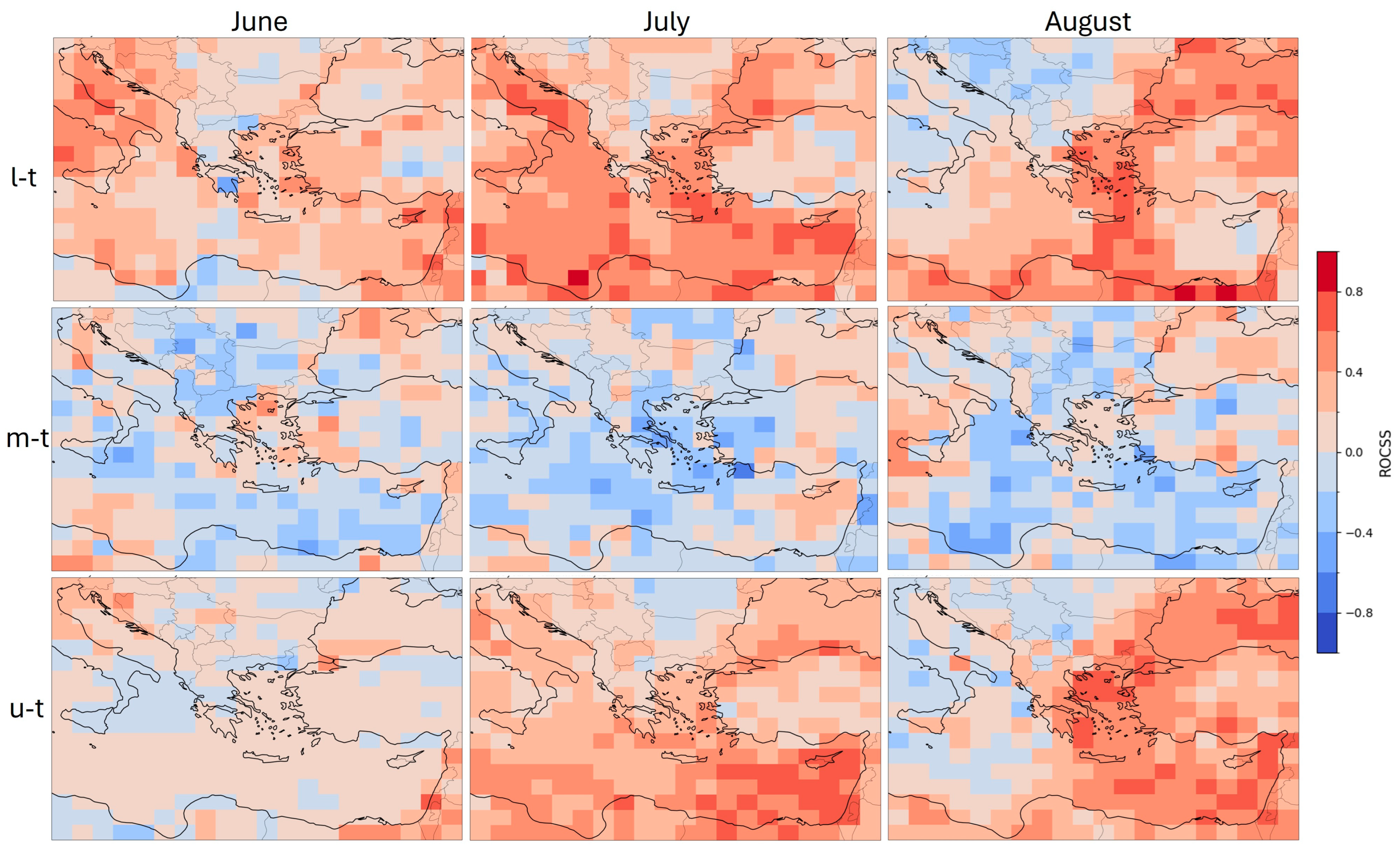ClimateHub: Seasonal to Decadal Predictions for National Renewable Energy Management †
Abstract
1. Introduction
2. Materials and Methods
3. Results
3.1. Near-Surface Temperature Seasonal Forecasts
3.2. Decadal Near-Surface Temperature Predictions
4. Conclusions
Author Contributions
Funding
Institutional Review Board Statement
Informed Consent Statement
Data Availability Statement
Acknowledgments
Conflicts of Interest
References
- Bloomfield, H.C.; Brayshaw, D.J.; Gonzalez, P.L.M.; Charlton-Perez, A. Sub-Seasonal Forecasts of Demand and Wind Power and Solar Power Generation for 28 European Countries. Earth Syst. Sci. Data 2021, 13, 2259–2274. [Google Scholar] [CrossRef]
- Troccoli, A.; Goodess, C.; Jones, P.; Penny, L.; Dorling, S.; Harpham, C.; Dubus, L.; Parey, S.; Claudel, S.; Khong, D.-H.; et al. Creating a Proof-of-Concept Climate Service to Assess Future Renewable Energy Mixes in Europe: An Overview of the C3S ECEM Project. Adv. Sci. Res. 2018, 15, 191–205. [Google Scholar] [CrossRef]
- Johnson, S.J.; Stockdale, T.N.; Ferranti, L.; Balmaseda, M.A.; Molteni, F.; Magnusson, L.; Tietsche, S.; Decremer, D.; Weisheimer, A.; Balsamo, G.; et al. SEAS5: The New ECMWF Seasonal Forecast System. Geosci. Model Dev. 2019, 12, 1087–1117. [Google Scholar] [CrossRef]
- Hersbach, H.; Bell, B.; Berrisford, P.; Hirahara, S.; Horányi, A.; Muñoz-Sabater, J.; Nicolas, J.; Peubey, C.; Radu, R.; Schepers, D.; et al. The ERA5 Global Reanalysis. Q. J. R. Meteorol. Soc. 2020, 146, 1999–2049. [Google Scholar] [CrossRef]
- Karali, A.; Hatzaki, M.; Giannakopoulos, C.; Roussos, A.; Xanthopoulos, G.; Tenentes, V. Sensitivity and Evaluation of Current Fire Risk and Future Projections Due to Climate Change: The Case Study of Greece. Nat. Hazards Earth Syst. Sci. 2014, 14, 143–153. [Google Scholar] [CrossRef]
- Cherchi, A.; Fogli, P.G.; Lovato, T.; Peano, D.; Iovino, D.; Gualdi, S.; Masina, S.; Scoccimarro, E.; Materia, S.; Bellucci, A.; et al. Global Mean Climate and Main Patterns of Variability in the CMCC-CM2 Coupled Model. J. Adv. Model. Earth Syst. 2019, 11, 185–209. [Google Scholar] [CrossRef]
- Jolliffe, I.T.; Stephenson, D.B. Forecast Verification: A Practitioner’s Guide in Atmospheric Science, 2nd ed.; John Wiley & Sons Ltd.: Hoboken, NJ, USA, 2003. [Google Scholar]
- Weigel, A.P.; Baggenstos, D.; Liniger, M.A.; Vitart, F.; Appenzeller, C. Probabilistic Verification of Monthly Temperature Forecasts. Mon. Weather Rev. 2008, 136, 5162–5182. [Google Scholar] [CrossRef]
- Manzanas, R.; Frías, M.D.; Cofiño, A.S.; Gutiérrez, J.M. Validation of 40 Year Multimodel Seasonal Precipitation Forecasts: The Role of ENSO on the Global Skill. J. Geophys. Res. Atmos. 2014, 119, 1708–1719. [Google Scholar] [CrossRef]




Disclaimer/Publisher’s Note: The statements, opinions and data contained in all publications are solely those of the individual author(s) and contributor(s) and not of MDPI and/or the editor(s). MDPI and/or the editor(s) disclaim responsibility for any injury to people or property resulting from any ideas, methods, instructions or products referred to in the content. |
© 2025 by the authors. Licensee MDPI, Basel, Switzerland. This article is an open access article distributed under the terms and conditions of the Creative Commons Attribution (CC BY) license (https://creativecommons.org/licenses/by/4.0/).
Share and Cite
Kartsios, S.; Misios, S.; Patlakas, P.; Varotsos, K.; Mavropoulou, I.; Kourantos, T.; Fountoulakis, I.; Gkikas, A.; Solomos, S.; Kapsomenakis, I.; et al. ClimateHub: Seasonal to Decadal Predictions for National Renewable Energy Management. Environ. Earth Sci. Proc. 2025, 35, 28. https://doi.org/10.3390/eesp2025035028
Kartsios S, Misios S, Patlakas P, Varotsos K, Mavropoulou I, Kourantos T, Fountoulakis I, Gkikas A, Solomos S, Kapsomenakis I, et al. ClimateHub: Seasonal to Decadal Predictions for National Renewable Energy Management. Environmental and Earth Sciences Proceedings. 2025; 35(1):28. https://doi.org/10.3390/eesp2025035028
Chicago/Turabian StyleKartsios, Stergios, Stergios Misios, Platon Patlakas, Konstantinos Varotsos, Ioanna Mavropoulou, Thanos Kourantos, Ilias Fountoulakis, Antonis Gkikas, Stavros Solomos, Ioannis Kapsomenakis, and et al. 2025. "ClimateHub: Seasonal to Decadal Predictions for National Renewable Energy Management" Environmental and Earth Sciences Proceedings 35, no. 1: 28. https://doi.org/10.3390/eesp2025035028
APA StyleKartsios, S., Misios, S., Patlakas, P., Varotsos, K., Mavropoulou, I., Kourantos, T., Fountoulakis, I., Gkikas, A., Solomos, S., Kapsomenakis, I., Kouklaki, D., Marinou, E., Bliziotis, D., Sergis, N., Vallianatos, D., Papatheochari, S., Giannakopoulos, C., Zanis, P., Amiridis, V., & Zerefos, C. (2025). ClimateHub: Seasonal to Decadal Predictions for National Renewable Energy Management. Environmental and Earth Sciences Proceedings, 35(1), 28. https://doi.org/10.3390/eesp2025035028










